What are the important reports that should be run and what are some things that I should look for to make sure everything is done properly for the financials of my dental practice?
What key indicators should I be checking daily, weekly, monthly basis?
How do I read and understand these reports to help me take the right action for the management of my dental practice?
This is exactly what we’re going to cover in this video.
I’m going to share what I do in my office to make sure that I, as the owner, KNOW and UNDERSTAND the ins and outs of the financials of my dental practice.
In the everyday business of the office, as clinicians – we’re focused completely on
seeing patients, start and finish treatment for each patient on time as much as possible
and do quality work that you’re happy with.
However, by the time we’re done with our last patient- you realize that you’ve done only one part of the job as a practice owner.
But now you’ve got to put on your hat as the business owner and actually sit down and make sure that whatever work you did on patients – you actually got paid for.
Or, if you take insurance, that you WILL get paid for.
And most importantly, this money actually ends up in your bank account.
Hundreds of practices every year are victims of embezzlement and if you and your team don’t have the right systems in place for checks and balances – things can slip through the cracks.
What this means is that money is going to slip through and you’ll be left wondering when you’ve been so busy in the last few months, you’re just not seeing the money that you expected.
When I was new in my startup practice, I didn’t really know where to look.
There are many reports that you can pull from your practice management system – I just didn’t know which ones to look at or what i was looking at.
It’s very confusing if you don’t understand what the numbers mean.
And if you don’t understand what the numbers mean – you’re not going to know which direction you need to go in or what action you need to take – so you DO get the results you want.
Overtime, through mistakes, some very costly – not just in terms of money, but also time – I learned these reports inside out so that now on a daily basis, I know:
- How much I produced in NET from working on patients
- How much is getting billed to insurance
- What I’m going to be paid after write-offs
- The correct adjustments are made – discounts and unpaid balances
- What’s coming in: from patients, insurance companies, from 3rd party financing companies
- How much money lands in my bank account compared to what I collected
I do want to start off by mentioning one thing.
When I speak about the specific reports and what you should be looking at – it’s going to be from Open Dental because that’s what I use in my practice.
But it does not matter what you have in your office – whether it’s Dentrix, Eaglesoft, Open Dental, Curve – whatever it is – the concepts I cover in this video – still apply and are universal.
You’ll be able to pull up the same reports on your system – so it’s more important you grasp the ideas and concepts.
To start off, I’m going to assume certain things are already in place:
- Your insurance fee schedules are set up correctly in your practice management system. If you happen to use Open Dental, then I’m also assuming that you’ve set up your PPO plans to plan type of “PPO Percentage”
- Insurance verification is done for every insurance patient and correct information is attached to their chart – this is so your practice management system can calculate patient copays correctly and have correct expected claim amounts attached to outstanding claims.
Alright, so let’s move forward with the first question.
What are some important reports that should be run, and what are some things that I should look for to make sure everything is done properly for financial reconciliations?
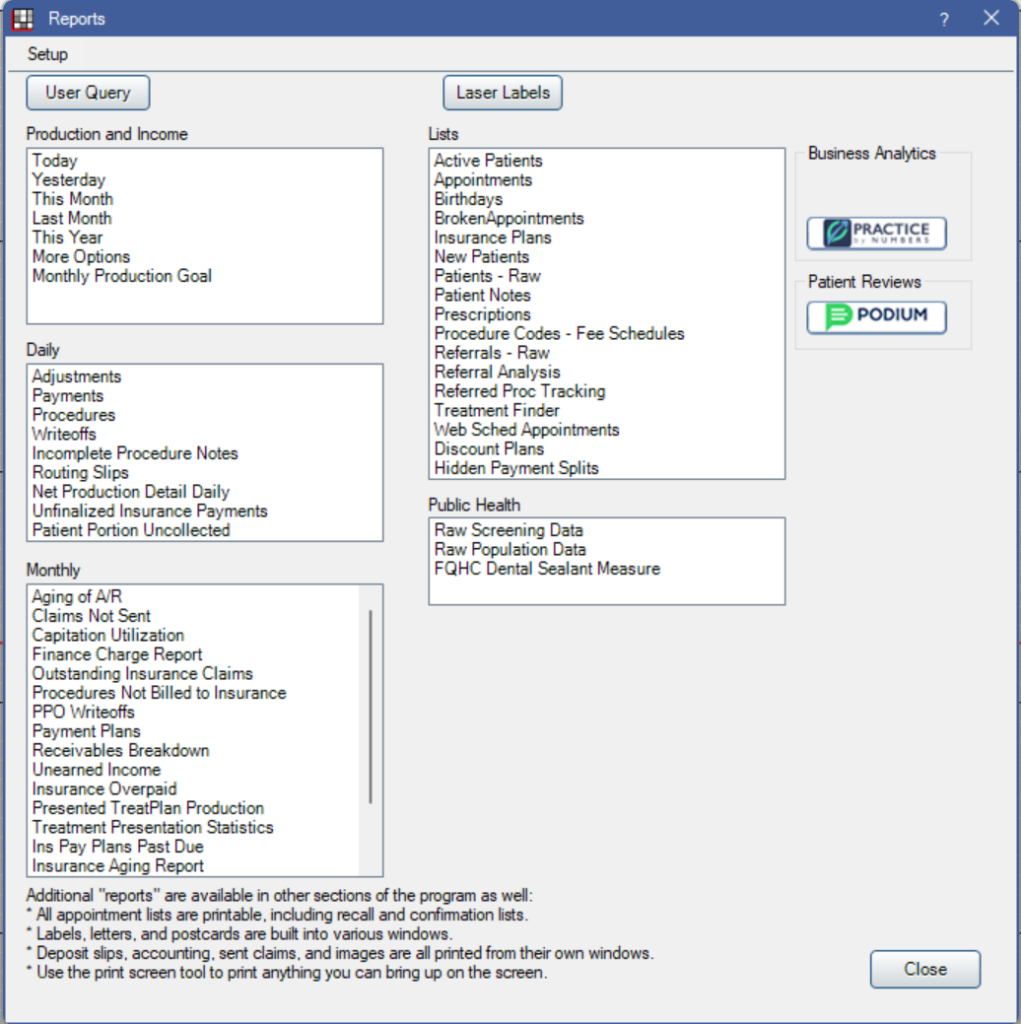
Most practice management systems come with a whole bunch of reports, but sometimes it’s overwhelming because you don’t know which ones you’re supposed to be looking at.
You certainly don’t need to run or use all of them.
The first thing to do is to understand what it is you’re trying to achieve.
What information are you looking for to help you make a decision?
Once you’ve answered that question, you can narrow down to the few reports that give you this information.
I’m going to focus on things that are available in most practice management systems including Open Dental.
However, there are some important things that I like to track on a daily basis, which aren’t directly available in most of the practice management systems.
Stick around to the end, and I’ll show you what other critical things I keep an eye on to make sure things don’t fall through the cracks.
Before considering weekly and monthly reports, I like to start with the most important day – which is TODAY!
What do I care about today?
1. For each appointment on the schedule, does Open Dental treatment plan reflect proper patient out-of-pocket payment due from patients?
I mentioned earlier that I’ll be making an assumption of correct set up of insurance plans and attached ins coverage information.
This is important because pending insurance payment from the claim you’ll generate for the procedures + expected patient out-of-pocket should equal the insurance allowable fee for the procedure.
And if you total that up for each procedure attached to the appointment – it should be the total net production for that appointment.
For each appointment on the schedule, it’s important to know how much net production is attached to that appointment.
At the time this appointment was created, correct procedures should’ve been selected from the treatment plan and attached to the appointment.
The patient for that appointment may have insurance, or maybe they’re on your in-office membership plan, or maybe a fee-for-service patient.
Whatever it is, when you click on appointment and go to the treatment plan, your team should be able to identify what they’re supposed to be collecting from the patient, and in the case if patient has insurance, how much reimbursement to expect from the insurance.
2. At the end of the day, I’d want to know how much did I produce in net? – meaning – what was my adjusted net production?
It’s the end of day, or maybe it’s the middle of the day and you’d like to find out how much you’ve produced in net so far.
You can utilize Open Dental’s Daily Production and Income report for this.
The report is going to show you patients seen, adjustments, estimated write-offs, and collections for the day.
3. End of day Collections: How much did we collect?
The money can be from patients directly, from insurance checks, 3rd party transactions (like CareCredit), and EFTs from insurances.
To find out how much you collected in form of patient payments and insurance payments – regardless of the form of payment – you’ll see the number on the report we just discussed.
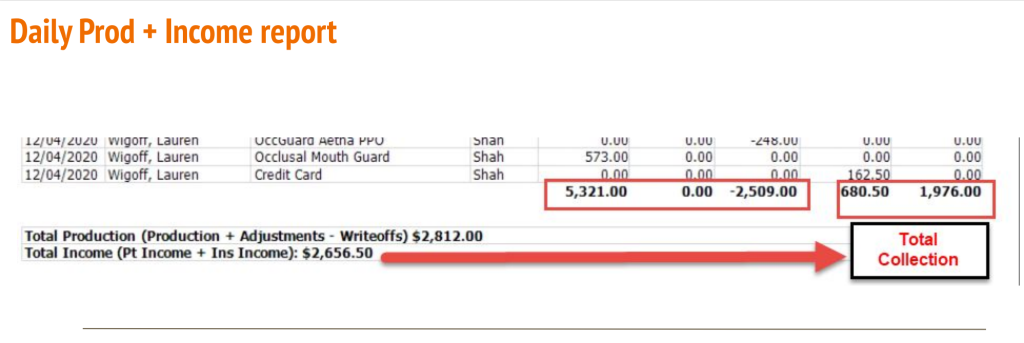
And all the way at the bottom you see Total Income – which is simply the total of the two.
To break down the collection in the different form of payments, you can pull up Payments Report from the list of Daily reports.
As you can see on the image below, for this particular day, you’re seeing the list of insurance checks, one eft payment from insurance, and patient credit card payments.
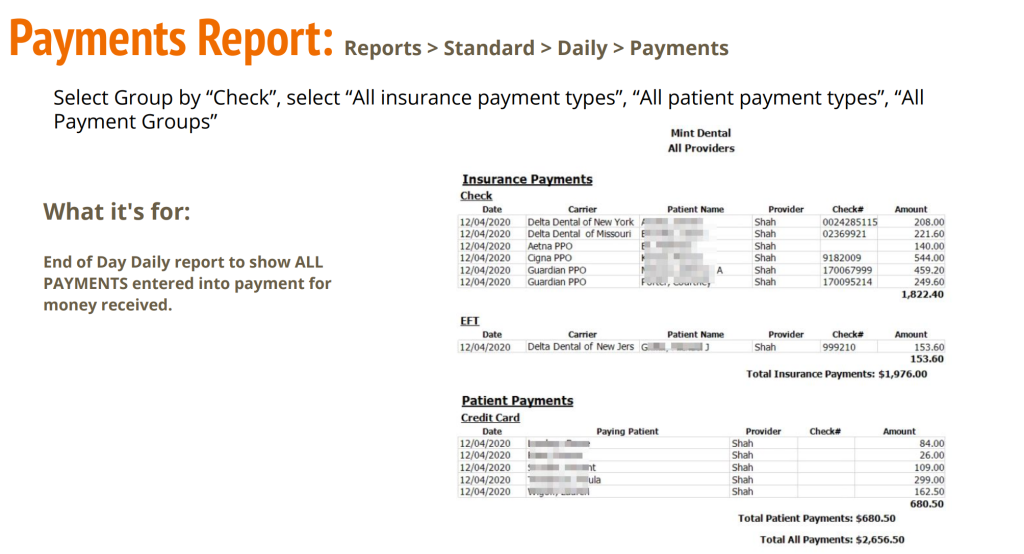
What I do in my practice at the end of the day is pull up this report, and match up every single one of the payments shown in the picture – insurance checks, efts, individual credit card receipts, and credit card totals report from terminal – to the payment report pulled up on the screen in front of you.
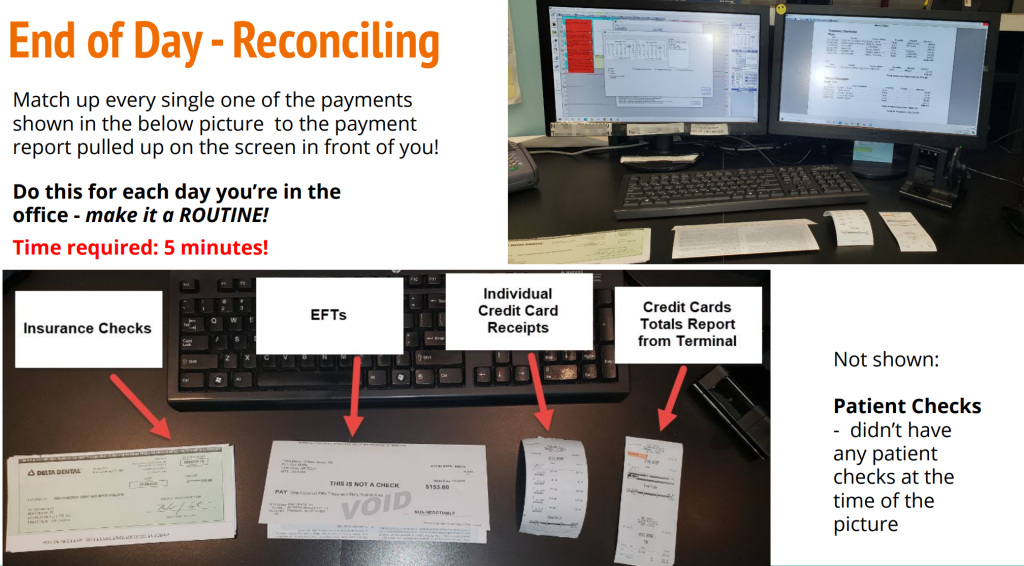
While you’re looking at insurance checks that have been entered – you also want to know if there were any payments that were LOWER than expected.
If you’re looking at a specific pending claim on the practice management system, it should show the expected amount of money from insurance.
If the payment being entered for the claim is lower than that, then you need to find out why that is, and figure out what the next plan is for the remaining balance.
Are you writing this balance off, or are you going to bill the patient for this and try to collect?
In my practice, if there’s going to a balance that we’re going to collect from the patient, we immediately set up a follow-up to reach out to the patient via Teamio’s A/R Follow-ups.
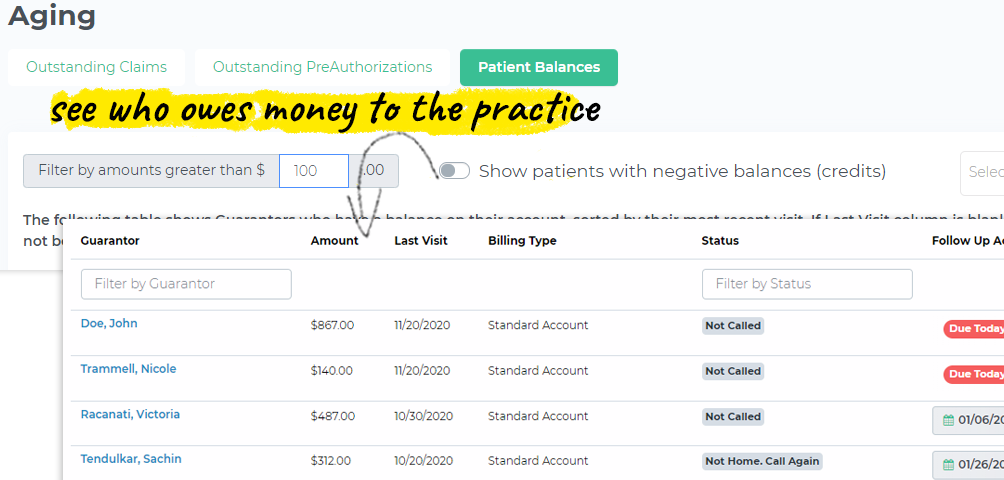
This is a reminder for my front desk who’s responsible for collecting the balance – to call the patient on the particular date we want to start following up.
This way you’ve already set up accountability for things that need to be completed.
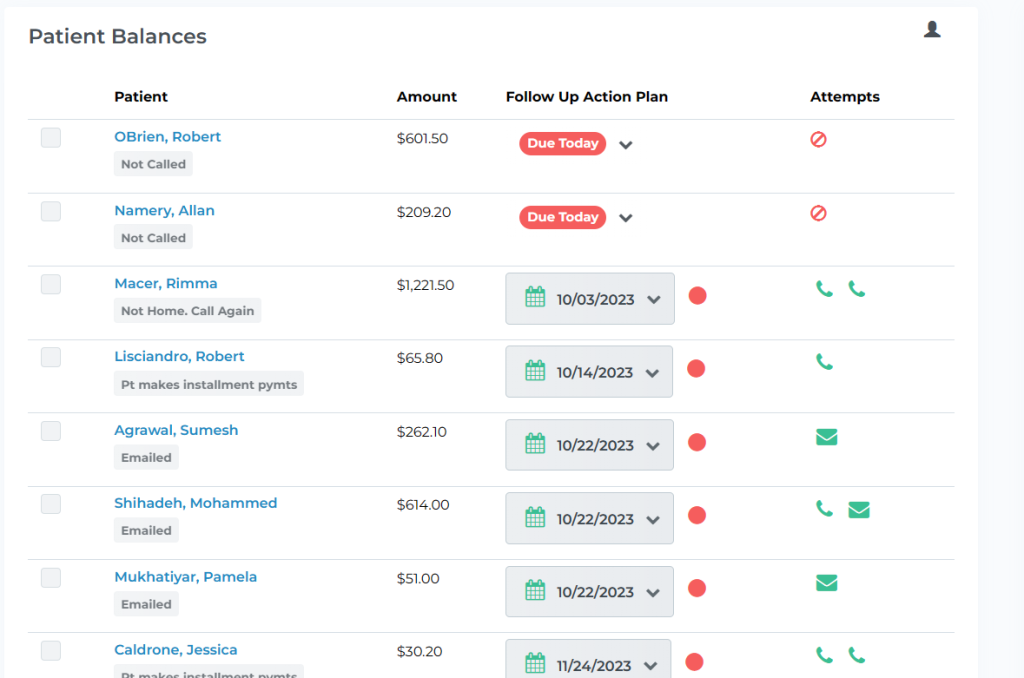
This is better in my opinion than relying on Open Dental’s aging report and looking through the list to see which patients need to be called.
4. Were there any Adjustments (courtesy discounts, membership plan discounts, etc.)?
Adjustments can be in form of:
- Courtesy discounts
- Membership plan discounts (depending on how it’s set up)
- Broken appointment adjustments (if they’re set up)
- Manual write-off of a patient balance that you decide to not collect.
At the end of the day, you need to know what adjustments were made or entered into your practice management system.
For Open Dental, you can pull up the Adjustment report from the list of Daily reports.
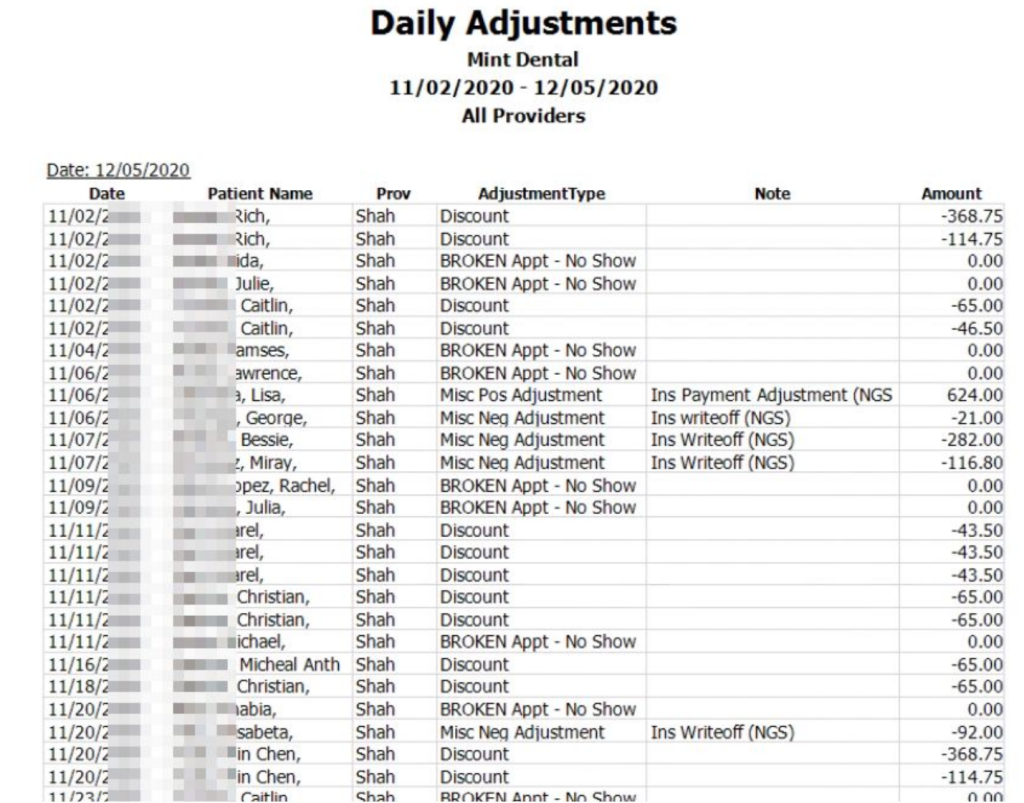
5. For all the appointments, are correct procedures attached prior to marking the appointment completed and generating the claim?
This is super important.
The provider – whether it’s a doctor or the hygienist, need to make sure whatever procedures were completed are attached to the appointment.
In some offices, the providers don’t really do this – they work on the patients, and then let the front know either via paper route slip or sometimes verbally what procedures were completed for the patient.
I find that it’s easier for the providers to simply select the procedures from the treatment plan and make sure they’re attached to the appointment for the patient that’s in their chair.
This way, when the patient is checking out at the front – the front desk team is going to mark the correct procedures completed and also generate a claim for those procedures if the patient has insurance.
6. Are PreAuths generated and ready to be sent for the patients we need them for?
If you saw patients today and you’ve treatment planned work that may need to be Pre-authorized, Preauthorizations claims need to be generated with these procedures attached.
To avoid delays on processing of these preauthorizations, you also need to make sure you’ve made available for your team to submit any supporting documentation – such as narratives, xrays, perio charting, intra-oral photographs, etc.
7. How’s the schedule looking for next 2 weeks?
Do we have holes in the schedule? Are you scheduled to your production goals?
Instead of worrying about my schedule 4 weeks from now, I prefer to focus on the next two weeks.
We all know patients cancel last minute – I find that anything beyond two weeks, there’s always more chance for holes to open up as things come up in patients’ schedule at home or work.
You can pull up Scheduled Production report from your Practice management system and see what your scheduled production is for the working days for the next two weeks.
In my practice, when I had a hygienist, I’d pull up this report and see scheduled production – but unfortunately, I can’t view the scheduled production broken down by provider.
In order to see individual providers scheduled production, I have to select each provider individually one by one and then generate the report.
I can always select multiple and just see totals, but it’s not broken down by providers.
And to do this for each day you’re in the office for the next two weeks was just super time consuming.
I now utilize Teamio’s “Next 2 Weeks” scheduled Production to give me a quick glance of what’s happening in next 2 weeks.
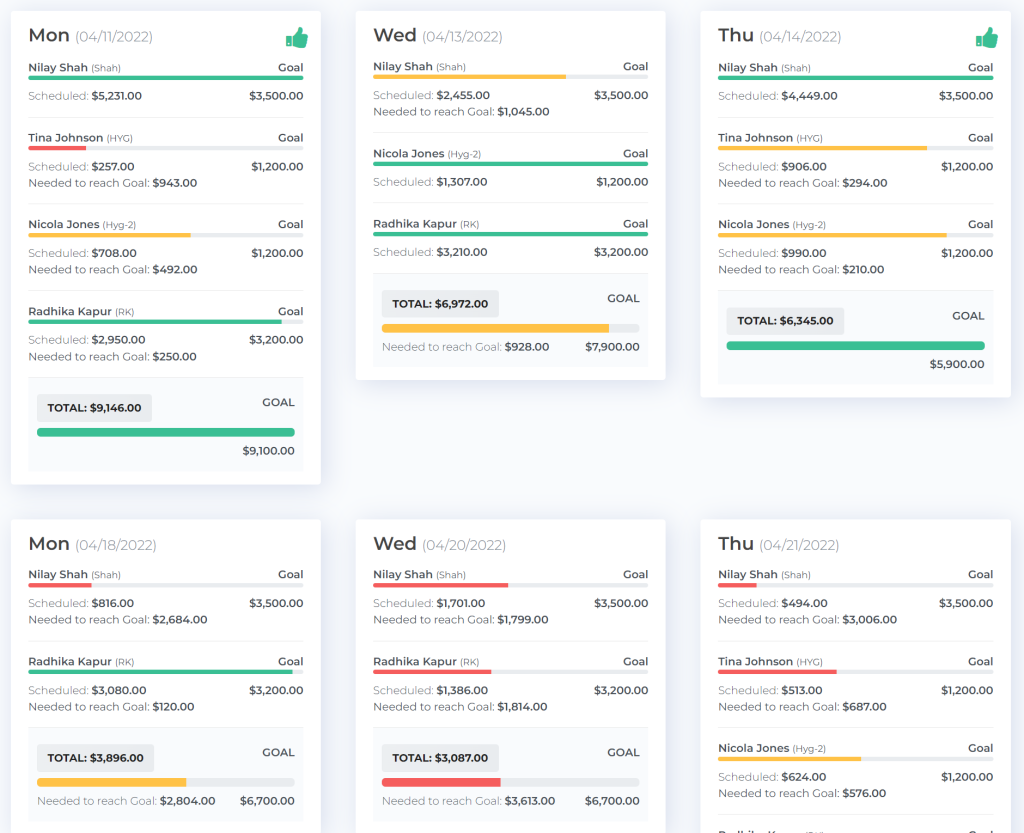
If I see a green thumbs up, I don’t need to worry because that means we’re scheduled to goals.
So I skip over and look for areas of concern which are areas in yellow and ones in red.
This is really for my scheduling coordinator who’s responsible for our schedule.
So it’s really a tool for her to make a quick decision of which days she needs to focus on to get the red to green and to meet our scheduled production goals.
I’m the only provider in the office and I’m there only two days, so I have my goals set up only for those 2 days.
If there were multiple providers, you’d be able to set up goals for any number of providers for any days of the week.
And it would automatically show you what’s scheduled for the provider according to what’s on the appointment book.
So those are the 7 things that are important for the reporting aspect on a daily basis.
Weekly Reports
Outstanding Insurance Claims Report
Once a week, you should be looking at Outstanding Insurance Claims report for claims that are more than 30 days old.
Meaning, you want to have your team look into claims where you haven’t been paid since 30 days have past from the date the claim was sent.
You can access this report in Open Dental under the monthly reports. Even though it’s under the Monthly section, it should really be run once a week to stay on top of your insurance AR.
Aging of Accounts Receivable (A/R) Report
This specific report, for instance, is used to track patient balances after considering insurance estimates, write off estimates.
What this means is that this report is going to show patient balances after taking into account estimated payments for claims that haven’t been marked received.
It’s also going to show patients who have a balance remaining that have all their claim payments made.
The patient balance can be from either the insurance not covering something you expected to get covered, insurance making a payment less than what you expect, patient not paying whatever they were supposed to pay on top of insurance.
Let’s look at a sample report.
Remember to keep this report as short as possible.
Review it weekly so you’re on top of balances that are owed.
Either track on excel, or add to “pop-ups” why certain balances exist.
In my practice, I now rely on Teamio’s Patient Balances feature to help us track all this and stay on top of who owes money, and who’s being followed up with.
Another nice report that’s built into Open Dental is the “Procedures Not Billed to Insurance Report”
Procedures Not Billed to Insurance Report
We like to run this report at the end of the week to get a list of patients who came in but never had a claim generated and sent out for payment.
Usually this report returns no one on the list since it would’ve been caught during our daily end of the day routines to make sure we’ve generated a claim for each appointment on the schedule.
But in case anything is missed, this report should help you catch ones that may have slipped through.
Monthly Reports
Net Production & Income Report
At the end of the last working day of the month – we run the “Net Production & Income report”.
You can also run it at the 1st working day of the next month and run the report for the previous month.
The information I’m looking for is what was the net production for the month and the collections.
Let’s look a sample report.
For the monthly financial reports, this is really the only report I look at.
When it comes to routines, there aren’t many monthly routines.
Daily routines take care of 90% of the work!
Weekly routines take care of the rest.
Other Critical things not readily available within Open Dental
Earlier I mentioned that there are things that aren’t directly available for you to see from your practice management system.
Just because they’re not available, doesn’t mean they’re less important.
In fact, they’re so important, I sometimes question why they aren’t built into the reports within existing practice management systems out there.
Case Acceptance rate: Treatment presented vs accepted / scheduled
One of these is measuring and keeping an eye on my own case acceptance rate.
Meaning, what am I diagnosing and treatment planning in terms of procedures and dollar amounts, and how much is actually getting scheduled and completed by patients.
The way I do this now is through Teamio’s Daily Huddle.
Tracking Patient Balances for Patients on the Schedule Today
I want a quick view of anyone coming in today for an appointment who may have a balance on their account.
The reason why this is important is to increase our chances of collecting on a balance that’s owed to you while the patient is right in front of you.
Instead of having to send statements, or having your team follow-up, there’s no better opportunity to collect on a balance than when the patient is in front of you.
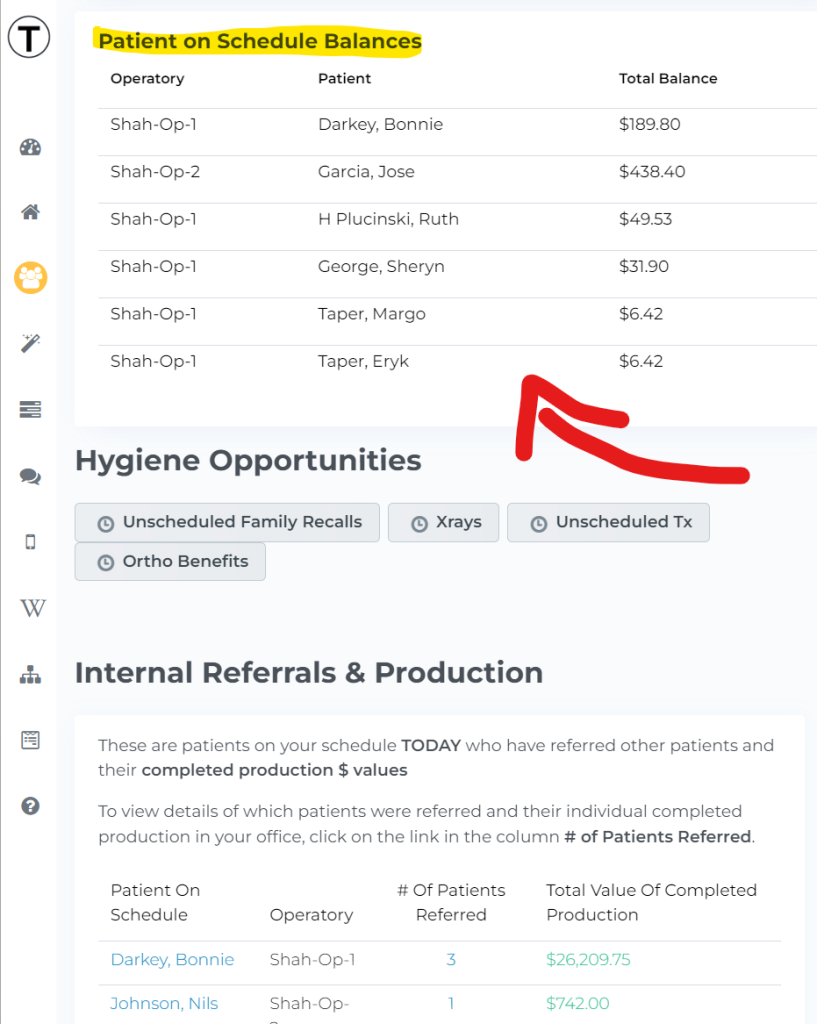
From Teamio’s Daily Huddle, I can immediately see that these are the patients coming in today for appointment and they have these balances on their accounts.
What I do is, in the morning, I’ll let my front desk know of the patients we should try to collect from before they’re brought in to the operatory for treatment.
So what this does is gets your team’s attention.
If your team is having to pull up a report, it’s just not going to happen because they’re going to forget.
But if it’s right in front of them, it grabs their attention because my front desk knows this is something we look at the first thing in the morning.
I won’t get into all the things we keep an eye on for daily routines, but I’ve brought this up because I’m trying to keep the focus on the financial aspects.
Ok, I hope this was helpful in understanding what key reports you need to pay attention to for the financials of your dental practice.
Remember, checking the daily, weekly and the monthly reports I mentioned, are only a part of the routines that need to be in place for the overall management of your dental practice.
Once you learn and understand the underlying numbers that make up these reports, it will help you take the right action.
The cumulative sum of these actions is what’s going to give you the results you’re looking for –
a leaner practice, lower overhead, more profitability, and ultimately more take home income for you.